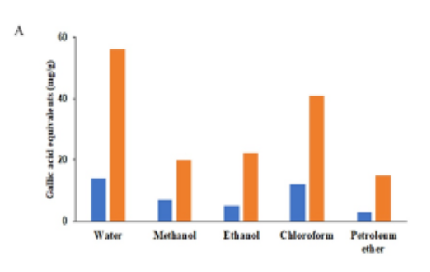


Indian Journal of Science and Technology
DOI: 10.17485/IJST/v15i47.1633
Year: 2022, Volume: 15, Issue: 47, Pages: 2594-2604
Original Article
Shameela Khadeeja1*, R Ragunathan1, Jesteena Johney1, Karnan Muthusamy2
1Department of Biotechnology, Centre for Bioscience and Nanoscience Research, Coimbatore, 641021, Tamil Nadu, India
2National Institute of Animal Science, Rural and Development Administration, Chungcheongnam, 3100, Cheonan, South Korea
*Corresponding Author
Email: [email protected]
Received Date:08 August 2022, Accepted Date:08 November 2022, Published Date:15 December 2022
Objectives: To perform a detailed phytochemical analysis, antimicrobial and antioxidant activity of leaf extracts of mangroves Bruguiera gymnorrhiza and Excoecaria agallocha. Methods: A comparative phytochemical analysis was done using qualitative and quantitative methods followed by antimicrobial activity and antioxidant analysis using DPPH. Aqueous and chloroform extracts of both mangroves were subjected to UV-Visible spectrum analysis. Further, the extracts were subjected to TLC, FTIR and GC-MS analysis to determine the different bioactive compounds present in the extract. Findings: The preliminary phytochemical analysis of different extracts revealed the presence of various phytoconstituents namely alkaloids, terpenoids, phenols and quinones. They had also shown significant antimicrobial activity against Staphylococcus aureus and Klebsiella pneumoniae. In DPPH analysis, the maximum antioxidant activity (% of inhibition) was observed in aqueous extract (67.2%) followed by methanol extract (67%) of Bruguiera gymnorrhiza, whereas in the case of Excoecaria agallocha, it was 64.9% in ethanol and 46.2 % in chloroform extracts. Further, GC-MS along with FTIR analysis of the extracts revealed the presence of numerous compounds that may contribute to the antimicrobial, and antioxidant potential and have great promise in treating various diseases. Novelty: Comparative study of the mangrove species Bruguiera gymnorrhiza and Excoecaria agallocha with five different solvents has been documented for the first time. In this study, both plants showed maximum activity against skin pathogens and further studies might help find new compounds against MDR pathogens. The findings of this study shed light on the folklore claim and immense potential of Bruguiera gymnorrhiza and Excoecaria agallocha to treat various ailments.
Keywords: Phytochemicals; Antioxidant; Bruguiera gymnorhiza; Excoecaria agallocha; Mangroves
© 2022 Khadeeja et al. This is an open-access article distributed under the terms of the Creative Commons Attribution License, which permits unrestricted use, distribution, and reproduction in any medium, provided the original author and source are credited. Published By Indian Society for Education and Environment (iSee)
Subscribe now for latest articles and news.